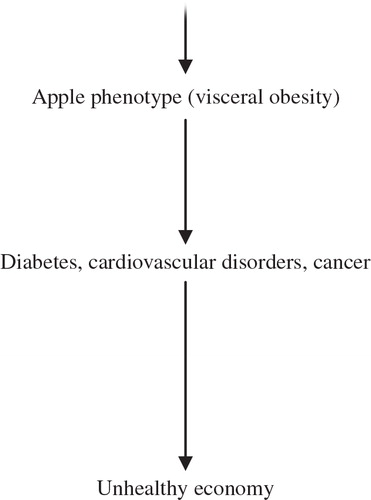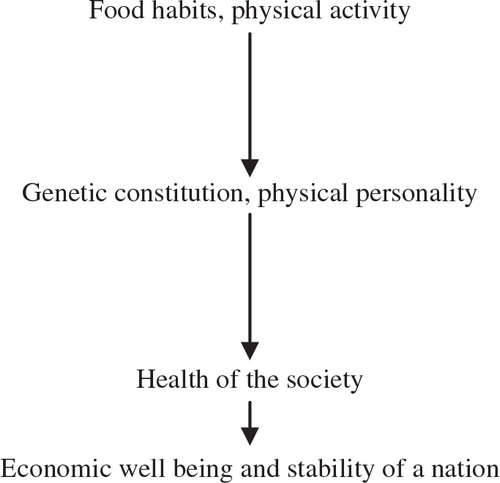Gluttony kills more than the sword. (George Herbert (1593–1633) English poet of the metaphysical school)
A gourmet is just a glutton with ‘brains.’ (Philip W. Haberman)
The life style ‘gluttony and sloth’ has become the central point of morbidity and the biochemical consequences of these are explained in the form of an extended arm of lipotoxicity resulting in hyperinsulinemia Citation1. It is suggested that certain selective activation of genes like proprotein convertase subtilin/kexin type 9(PCSK9) involved in LDL receptor metabolism could help eliminate gluttonous and slothful members of society. It is speculated that such an elimination would guarantee the youngest members of the society a fair share of the food available during periods of limited food supply. Society's strength lies in its health and a young generation, which are human investments of a country's well-being.
In a world with an obesity pandemic adipose tissue has assumed a vital role in the understanding of the global phenomenon of adiposity in health and disease Citation2Citation3. Obesity could be considered as a phenotypic expression of impending metabolic syndrome and it is associated with coronary artery disease (CAD), diabetes, and now non-alcoholic fatty liver disease (NAFLD). A scientific explanation was given in biochemical terms through the concept of ‘thrifty gene.’ The ‘thrifty gene’ concept explains the importance of adipocytes as storage depot of lipids to meet the fuel requirements of lipid-intolerant non-adipose tissues during starvation. During fuel-surplus periods adipose tissue could protect non-adipose tissue from lipotoxicity (i.e. the metabolic syndrome) Citation4Citation5. This was explained in much simpler terms by an ancient Indian saying:
‘Gluttony and sloth will act like poison and kill you.’ (Anon)
It is high time that we understand the wisdom behind our tradition and culture including our food habits. The society we live in is influenced by our health. We need to understand the impact and miscegenation of habits like culture of other regions including food habits on our society. Every region and race has evolved over the years adopting the rightful mixture of food habits suited to the genetic constitution and physical attributes of personality of the race. Take the example of a camel which stores lipids both as a source of fuel and water derived from metabolism. This holds good for humans also. Our physical constitution has been tuned to the food habits and the environment we live in. It is high time that we take serious stock of the situation the world is facing due to this neglected aspect of human health. In this article an attempt has been made to analyze the food habits of a country like India which is very much diversified in its ethnicity as well as in its culture including its food habits. An understanding of these differences in food habits and its impact on health will be an eye-opener to us to understand the oft neglected ancient wisdom and our negligence of nature, the greatest teacher of our lives.
Every country is polluted with environmental toxins as well as food habits aped from western society. The western fast food culture has revolutionized the field of nutrition as well as affected the health status of local communities. For example, most of the Indian physical attributes and their bodies are not used to fat rich and fully processed food of western food. The body mass index (BMI) which is taken as a physical marker of obesity is comparatively lower for a south Asian population compared to the western population (<25 and <30, respectively) Citation6. The genetic constitution as well as its phenotypic expression in the form of body habitus varies from race to race. Therefore the aping of western culture including its dietary habits are the basic contaminants of local health ().
From, ancient times Indian food has been on principle, divided into the Satwik and Rajsik kinds. The former was the food which was supposed to be more inclined towards spirituality and health. It included vegetables and fruits, but not onions, garlic, root vegetables, and mushrooms. The more liberal Rajsik food was a general food consumed by all the people with the exception of beef in certain places Citation7.
India is a country rich in tradition and culture. Indian cuisine is unified in the use of spices and diversified in the use of vegetables compared to any other cuisine in the world. The flavor and components of Indian cuisine are influenced by religious and caste restrictions, weather, geography, and the impact of foreigners Citation7. Spices have always been considered to be India's prime commodity.
‘Paan’ is served as a digestive inducer after having meals. The dark-green leaf of the betel-pepper plant is smeared with a little bit of lime and wrapped around a combination of spices like crushed betel-nuts, cardamom, aniseed, sugar, and grated coconut. It is an astringent and is believed to help in clearing the system Citation7.
One must remember food is considered as a medicine. Most of the spices used in Indian food have been used due to their medicinal properties in addition to the flavor and taste they impart. Ginger is believed to have originated in India and was introduced to China over 3000 years ago. In India, a knob of fresh ginger added to tea is believed to relieve sore throats and head colds. Turmeric is splendid against skin diseases and neem leaves are used to guard against small pox. The nutritive and medicinal value of food and food habits have a greater influence on human health Citation8. Human health is the key component of a society which in turn influences its well being as well as its economy ().
The saying ‘too much of anything is toxic’ holds true of our eating habits and therefore our lifestyle and health. The concept of health cannot be taken out of context and dealt with separately if we wish to live in a healthy society.
Dhastagir S. Sheriff and F.A. Elsharri
Department of Biochemistry
Faculty of Medicine
Garyounis University
Benghazi, Libya
Email: [email protected]
References
- Roger H, Unger RH, Scherer PE. Gluttony, sloth and the metabolic syndrome: a roadmap to lipotoxicity. Trends Endocrinol Metab. 2010; 21: 345–52.
- Adel E, Marie-Francoise RC, Salaheddin MM, Najeeb E, Ahmed AM, Ibrahim B, et al.. Nutritional status of under-five children in Libya; a national population-based survey. Libyan J Med. 2008; 3: 13–9.
- Alshkri MM, Elmehdawi RR. Metabolic syndrome among type-2 diabetic patients in Benghazi – Libya: a pilot study. Libyan J Med. 2008; 3: 177–80.
- Neel JV. Diabetes mellitus: a “thrifty” genotype rendered detrimental by “progress”. Am J Hum Genet. 1962; 14: 353–62.
- Ford ES. Prevalence of the metabolic syndrome defined by the International Diabetes Federation among adults in the US. Diabetes Care. 2005; 28: 2745–9.
- WHO Expert Consultation. Appropriate body-mass index for Asian populations and its implications for policy and intervention strategies. Lancet. 2004; 363: 157–63.
- Kumar S. “Soil, Soul, Society”. Resurgence. No. 200, May/June 2000.
- Morton M. Cupboard Love: A dictionary of culinary curiosities. Insomniac Press. Toronto Ontario, 2004

